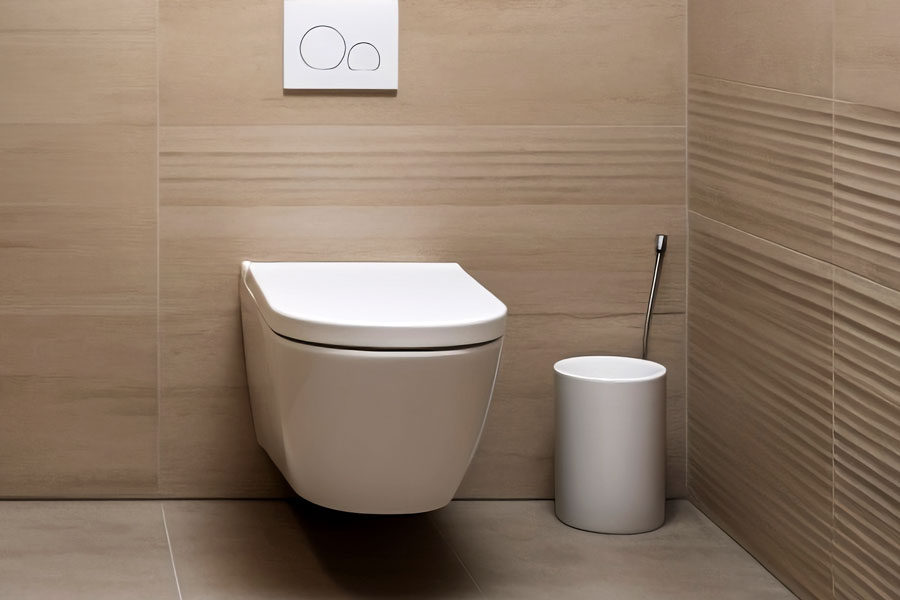In this article, we'll explore the pros and cons of inspection hatches for wall-hung WCs. These practical devices offer easy access to pipework and fittings hidden behind the wall. However, they can pose certain aesthetic problems, compromising the visual appearance of your bathroom. Discover all the important aspects to consider when choosing a trapdoor for your wall-hung WC.
Lack of space in the bathroom doesn't prevent the installation of bathroom equipment
[arve url="https://www.youtube.com/embed/nrbq_t0chB0″/]
What are the advantages of a wall-hung toilet?
The advantages of a wall-hung WC
A wall-hung WC has become increasingly popular in recent years due to its many advantages. Here are some of the most important advantages:
1. Space-saving : The main advantage of a wall-hung toilet is that it saves space in the bathroom. Because it's wall-mounted, there's no bulky tank on the floor, which creates a feeling of space and makes cleaning easier.
2. Modern design : Wall-hung toilets are often considered more aesthetically pleasing and modern than traditional toilets. Their uncluttered appearance and minimalist design blend perfectly into any bathroom, whatever the decor.
3. Easy to clean : Thanks to their elevated position, wall-hung toilets are easier to clean than traditional toilets. There are no hard-to-reach corners, making cleaning fast and efficient.
4. Height-adjustable : Some wall-hung WC models are height-adjustable, making them suitable for all members of the family, including the elderly and people with reduced mobility.
5. Better hygiene : Wall-hung toilets are often equipped with a powerful flushing system that allows the bowl to be rinsed thoroughly, reducing the risk of bacteria and unpleasant odours.
6. Water saving : Many wall-hung WC models are designed to be more water-efficient than traditional WCs. Thanks to their dual-flush system, they reduce water consumption and save on water bills.
In conclusionSuspended WCs offer many advantages, including space-saving, modern design, ease of cleaning, improved hygiene, water savings and height adjustment. They have become a popular choice for those looking for a practical and aesthetic solution for their bathroom.
Are wall-hung toilets sturdy?
Yes, wall-hung toilets are solid and reliable. These types of toilets are designed to be wall-mounted, making them very stable. They are made from strong, durable materials such as ceramic or reinforced plastic. What's more, they undergo resistance tests to guarantee their sturdiness. Another advantage of wall-hung toilets is that they are easy to clean and take up less space in the bathroom. In conclusion, wall-hung toilets are a solid, practical option for any sanitary installation.
Which toilet takes up the least space?
There are many models of WC that don't take up much space. These include Wall-hung toilets are often the preferred choice, as they do not require the installation of a floor tank. They offer a compact, aesthetic solution for small spaces.
Compact WCs are also an interesting option for those looking to optimize space. They are designed with reduced dimensions, yet offer the same comfort as a standard toilet.
It is also possible to find Corner WCwhich are specially designed to be installed in a corner of the bathroom. This maximizes available space without compromising functionality.
In conclusion, there are a variety of space-saving WC options to suit the constraints of small spaces.
How to open the trapdoor of a wall-hung toilet?
To open the flap of a wall-hung toilet, follow the steps below:
1. First of all, locate the trapdoor on the wall where the toilet is mounted. It's usually located at the back of the bowl.
2. Once you've found the hatch, locate the handle or opening that unlocks it.
3. Use your hand to grasp the handle, or insert your fingers into the opening. You should feel some resistance when you try to unlock it.
4. Using light pressure, pull or push the handle or opening in the direction indicated by the arrows on the hatch. This will open it easily.
5. Once the flap is open, you'll have access to the inside of the wall-hung WC. This allows you to carry out any necessary maintenance operations, such as servicing or cleaning.
It's important to note that each model of wall-hung toilet may have a slightly different method of opening the flap. We therefore recommend that you consult the manufacturer's user manual if you encounter any difficulties.
Don't forget to close the hatch carefully once you've finished, locking it securely to avoid any future problems.
By following these steps, you should be able to open the trapdoor of a wall-hung toilet without too much difficulty.
In conclusion, the inspection hatch for wall-hung toilets offers a number of advantages benefits and disadvantages. On the one hand, it offers considerable ease of access when it comes to carrying out repairs or maintenance on the tank or pipes. It also saves time and effort, avoiding high labor costs for interventions requiring professional intervention.
On the other hand, the installation of a trapdoor can compromise the aesthetics of the bathroom, as it is often located in a visible area. What's more, it's important to choose a durable, quality material to avoid leakage or structural problems in the long term.
Ultimately, the choice to use a wall-hung toilet access panel will depend on each person's individual needs. It's essential to consider the practical advantages as well as the potential aesthetic drawbacks in order to make an informed choice.








